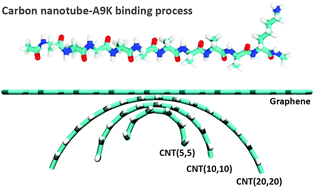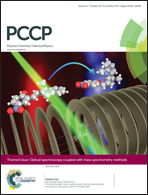Polypeptide A9K at nanoscale carbon: a simulation study†
Abstract
The amphiphilic nature of surfactant-like peptides is responsible for their propensity to aggregate at the nanoscale. These peptides can be readily used for a non-covalent functionalization of nanoparticles and macromolecules. This work reports an observation of supramolecular ensembles consisting of ultrashort carbon nanotubes (USCNTs), graphene (GR) and A9K polypeptides formed by lysine and arginine. The potential of mean force (PMF) is used as a major descriptor of the CNT–A9K and GR–A9K binding process, supplementing structural data. The phase space sampling is performed by multiple equilibrium molecular dynamics simulations with position restraints, where applicable. Binding in all cases was found to be thermodynamically favorable. Encapsulation in the (10,10) USCNT is particularly favorable. The curvature of the external surface does not favor binding. Thus, binding of A9K at GR is stronger than its binding at the outer sidewall of USCNTs. Overall, the presented results favor non-covalent functionalization of nanoscale carbons that are considered interesting in the fields of biomaterials, biosensors, biomedical devices, and drug delivery systems.


 Please wait while we load your content...
Please wait while we load your content...